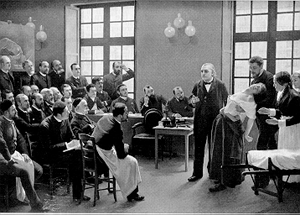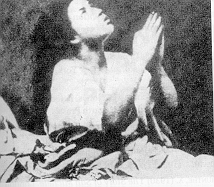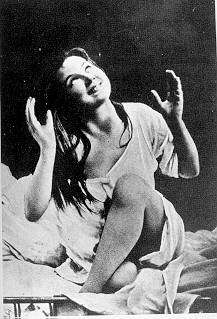Discourse (Representation p.
44-)
- as a
system of representation-- "What interested him were the
rules and practices that
produced meaningful statements and regulated discourse in different
historical periods."
- about language
and practice--Discourse
is "a group of statements which
provide a language for talking about ...a particular topic at a
particular historical moment." "Discourse, Foucault argues, constructs the
topic. It defines and produces the objects of our knowledge.
It governs the way that a topic can be meaningfully talked about and
reasoned about.
[e.g. hysteria, sexuality,
homosexuality, Romantic love in late 19th century.]
nothing which is meaningful exists outside
discourse--"nothing
has any meaning outside of discourse"
the study of the discourses [of madness, punishment, sexuality, or
Romantic love, etc.] must
include the following elements:
- statements about 'madness' ...
- the rules which prescribe certain
ways of talking about these topics and exclude others (rules of
inclusion and exclusion)
- 'subject' who
in some ways personify the discourse--the madman, the hysterical
woman, the Romantic hero, etc.
- how this knowledge about the topic
acquires authority,
a sense of embodying the 'truth' about it...
- practices within institution for
dealing with the subjects--medical treatments for the insane,
punishment regimes for the guilty, ways of reading Romantic poetry,
night walk for Romantic poets, admiration of Romantic hero, etc.
- discursive formation--the emergence
of a new discourse, decline of the old one
--history as discontinuous, with
ruptures, radical breaks
TOP
Discourse--knowledge--power
(e.g. knowledge about sex)
--knowledge linked to power, not only
assumes the authority of 'the truth' but has the power to make
itself true.
--not the 'Truth" of knowledge in the
absolute sense--...but of a discursive formation sustaining a regime
of truth.
--power circulates: It is never
monopolized by one centre. It 'is deployed and exercised through a
net-like organization.'
--power is not only negative; it is also
productive. "it traverses and produces things, it induces
pleasure, forms of knowledge, produces discourses." (Representation 49-50)
TOP
Power and Subjectivity
Discourses themselves [are] the bearers of
various subject-positions: that is, soecific positions of agency and
identity in relation to particular forms of knowledge and practice.
subject--produced within discourse, subjected
to discourse.
subject position--[for us to become the
subject of a particular discourse, and thus the bearers of its
power/knowledge] we must
locate ourselves in the position from which the discourse makes most
sense, and thus become its 'subjects' by subjecting' ourselves to its
meanings, power and regulation.
TOP
Example 1--hysteria, disease or
performance?
|

Andre Brouillet, A
clinical lesson at La Salpetriere (given
by Charcot), 1887
|
(Representation 52-53)
This painting represents a regular feature of Charcot's
treatment regime, where hysterical female patients displayed
before an audience of medical staff and students the
symptoms of their malady, ending often with a full
hysterical seizure.
This painting could be said to
capture and represent, visually, a discursive 'event'--the
emergence of a new regime of knowledge. |
|

portrait of
Augustine: Amorous supplication "Among
the most frequently photographed was a fifteen-year-old girl
named Augustine, who had entered the hospital in 1875.
Her hysterical attacks had begun at the age of thirteen
when, according to her testimony, she had been raped by her
employer, a man who was also her mother's lover.
Intelligent, coquetish, and eager to please, Augustine was
an apt pupil of the atelier. All of her poses suggest
the exaggerated gestures of the French classical acting
style, or stills from silent movies. ...also seem to
imitate poses in 19th-century paintings [e.g. Ophelia, or Beata
Beatrice] (Showalter in Representation 73-74)
|

portrait
of Augustine: Ecstasy
|
Example 2--subject positions in Las
Meninas (pp.
58-61)
- "Foucault
reads the painting in terms of representation and the subject"
(Dreyfus and Rabinow, 1982, p. 20). . . . the painting tells
us something about how representation and the subject work.
- The meaning of the
picture is produced, Foucault argues, through this complex
inter-play between presence (what you see, the visible) and absence
(what you can't see, what has displaced it within the frame).
- Two centers
-- the Infanta and Royal Couple. Far
from being finally resolved into some absolute truth which is the
meaning of the picture, the discourse of the painting quite
deliberately keeps us in this state of suspended attention.
- Our look --
our identification with one subject position For
the painting to work, the spectator. . . must subject him/herself to
the painting's discourse and, in this way, become the painting's
ideal viewer.
- Three subject
positions.
TOP
From another book:
Example 3--study of images
-
Foucault's arguments about discursive
formations--we should not focus on one or two privileged images, but
grasp the regularities which linked
the different manifestations of a certain imagery togetheracross
different sites of representation.
- Foucault's
arguments about discursive specificity--we need to attentive to the
specific discursive codes and
conventions through which ...is
signified ...
- Foucault's
insistence on the operation of power through discursive regimes--
opens up the possibility of analyzing the power
relations which function in the
construction of these images.
- Foucault's emphasis
on the institutional dimension of discourses -- how the images were
rooted within specific institutional practices ...
- Foucault's
contention about the discursive production of subjectivity-- a set
of images as a new subject position opened up ...
TOP
|


